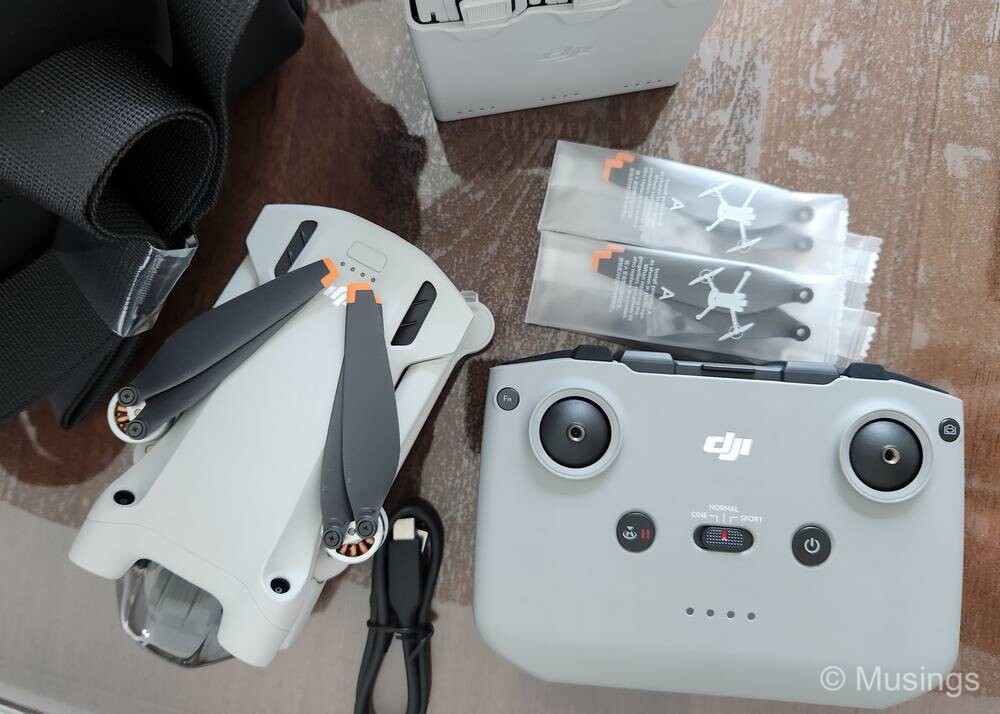The DJI Mini 3 Pro is considered to the top-dog and top of range of DJI’s current line of under 250g drones. The pricing certainly matches that level of ‘professional’ features: the cost of the drone bundled with my chosen controller (more on that later) with the Fly More kit was SGD1303. Ouch!
Since this was the only model that met the three requirements I had, my decision on what specific drone model was pretty quick and easy. I also opted for the standard Fly More Kit rather than the Plus version of the kit as the latter would have put the takeoff limit past 250g. Deciding what bundled drone controller to go for however was a very hard decision.
Journaling for posterity’s sake, there are two options: the RC-N1 controller which was introduced a few years ago, and the new RC controller. The singularly largest difference between the two – apart from that the bundle with the RC controller is SGD240 more expensive – is that the latter has a built-in 5.5″ screen. So, no more having to pull out your phone, fix it to the controller, and establish a connection between the two before you get the two tethered devices to next connect to the drone. There is also the overall sizing and weight savings: a single combined device is just that much more convenient and comfortable to use.
Opinion in the drone user community between whether to get the RC-N1 and RC versions is really divided. No one disagrees with the convenience that an all in one device in the form of the RC brings about. But many also pointed out limitations of going with the RC. Specifically, the screen brightness of 700bits while respectable might not be sufficient for use in broad daylight. Also, many users also commented that the customised Android operating system in the RC felt somewhat lethargic, a point also remarked on by my DFA instructor. Against that: drone owners with reasonably recent and good smartphones would benefit from the RC-N1, since the phone screens might offer higher brightness levels than 700 nits. You also get options for a larger than 5.5″ display, and you can even fit an extension for iPad Mini if that’s your thing. Finally, there is also that convenience of being having basic imagery and video clips cached into the phone for immediate posting to social media.

I went back and forth between both controller bundles, and was initialy prepared to bite the bullet and pay the higher price for the RC controller version as I was lured in by convenience. But at the last minute, opted for the RC-N1. Aside from the SGD240 savings, I concluded that since I would be often flying in sunny conditions (i.e. Singapore), screen brightness is important. And I’m also equally spoiled on using OLD type displays with high refresh rates and brightness levels. So, it was the DJI Mini 3 Pro with the RC-N1 controller + Fly More kit.
My initial impressions of the new drone after my first test flight at Bishan-Ang Mo Kio park last weekend are very positive: the drone is super easy to fly, the RC-N1 controller with my old Samsung S21 Ultra tethered to it was a setup that was a little clunky, but interfacing is buttery smooth. I’ve just picked up a cheap smartphone for dedicated use with the RC-N1 controller though: the Poco X4 Pro 5G – whose display like the S21 Ultra supports a 120Hz refresh rate – but also offering an extremely bright 1200 nits peak brightness. More than sufficient for use in very sunny days.
A short 30 second clip of my first test flight, with music from EpidemicSound.
More notes to come on my using and learning how to fly the Mini 3 Pro!